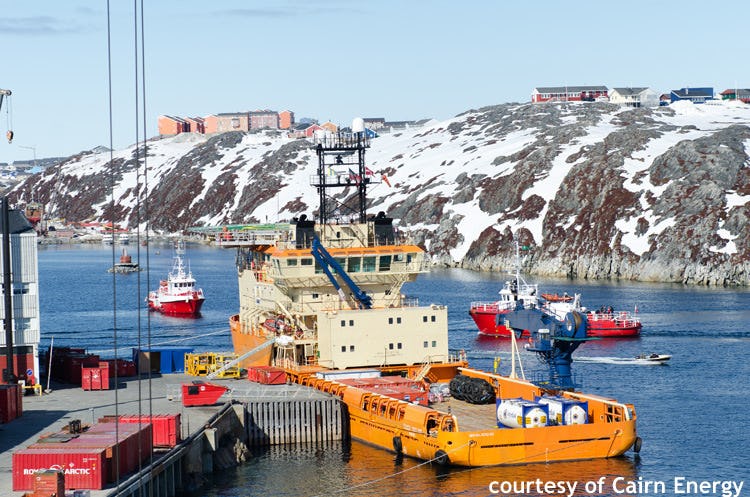Cairn Energy Abandons Second Well on West Coast of Greenland

Toisa Vigilant in Nuuk, Greenland. Photo: Cairn Energy
Cairn Energy, an Edinburgh-based oil and gas explorer, announced that it is abandoning its Gamma-1 exploration well off the west coast of Greenland. The failure to find oil or gas represents the second setback for Cairn this year. It also drew a blank at its southern well LF7-1 and suspended work on its AT7-1 well. Furthermore, equipment used on what was thought to be its most promising well, Delta 1, is scheduled to move further south to complete drilling operations at AT7-1, after Delta-1 “encountered several hundred meters of tertiary volcanic section” and shows only minor hydrocarbon indications. In total Cairn plans to drill five wells in the Arctic this summer.
Cairn, which is investing around $600 million this year into its Arctic drilling operations, is leading the charge into offshore oil exploration in Greenland. Even prior to the latest setbacks the company announced that it hopes to bring in a partner to help with its Greenland operation. Exxon Mobil, Husky Energy, and Chevron also have plans to begin drilling above the Arctic Circle.
The Scottish oil and gas explorer started exploration in the Arctic during the summer of 2010 but failed to find oil or gas during the narrow three-month window when weather conditions in the harsh Arctic environment allow for operations to take place.
In addition to representing a significant capital investment, Cairn’s Arctic operation has been the target of extensive protests by environmentalists, primarily Greenpeace, which may lead to irreversible damage to Cairn’s reputation. Environmental activists managed to board the company’s drilling equipment during the summer of 2010 and 2011 to highlight their opposition to drilling operations in the fragile Arctic ecosystem. Greenpeace argues that even a minor oil spill would have devastating consequences and would be impossible to clean up due to a lack of infrastructure and equipment above the Arctic Circle.
Cairn’s Arctic operations serve as an example of the continued challenges future oil and gas exploration in the High North will face. Despite continued melting of sea ice and strong climatic warming in the Arctic working conditions will remain challenging even during the short summer season. The high capital costs of developing a field in the extreme Arctic environment far removed from existing infrastructure and consumers may continue to represent a key obstacle for an Arctic exploration bonanza to materialize in the near future. The development of the Shtokman field in Russia’s part of the Barents Sea has been delayed since 2006 and was postponed by another 3 years in February 2010.
Exxon Mobil’s deal with Russia’s largest oil producer OAO Rosneft earlier this month exemplifies the vast capital investments necessary to develop offshore oil and gas resources in the Arctic. According to Prime Minister Putin the total investments envisioned under the agreement could reach $500 billion, of which $200-300 billion would be direct investments in the region.